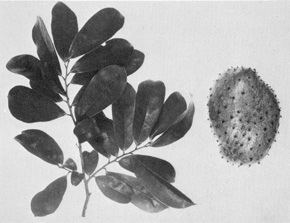|
References: Fouqué 1974, Popenoe 1939. Annona murlcata L. Common names: soursop (English); catoche, guanabana (Spanish); anone, corossolier (French); curassol, coracao de rainha (Portuguese). Distribution: Pantropic. Cultural requirements: Hot tropical lowlands with high rainfall. Very susceptible to frost injury. Description: Tree to 8 m. Propagation by seed, graft-ing. Fruit production in 4-5 years from seed, 2-3 years from grafts. Flowering season May-June, October-November (Florida). Poor fruit set is a frequent problem, possibly because of poor polli-nation. Fruit matures in 70-120 days. Fruit 15-35 cm long, 1,000-4,000 g, solitary; external color green, internal white. Utilization: Pulp eaten fresh, made into juice, ice cream, other desserts. Flavor sweet to subacid, excellent; universal appeal. Potential for commer-cial production excellent. References: Fouqué 1974, Popenoe 1939, Ruehle et al. 1958. 
Figure 12. Soursop, a sour fruit that almost everyone likes. |
Annona purpurea
Moc. at Sessé Common names: soncoya (English); soncoya, cabeza de negro (Spanish); atier, corossol, coeur de boeuf (French); cabeza de negro (Portuguese). Origin: Mexico, Central America. Distribution: Tropical America, Philippines. Cultural requirements: Hot tropical lowlands with medium to high rainfall. Description: Tree to 12 m. Propagation by seed. Fruit 15-20 cm in diameter, solitary; external color brown to gray, internal orange. Utilization: Pulp eaten fresh. Flavor aromatic; limited appeal. Little potential. References: Fouqué 1974, Popenoe 1939. Annona reticulata L. Common names: custard apple, bullock's-heart (English); anon, anona corazón, chirimoya (Spanish); coeur de boeuf (French); condesa, coraçao de boi (Portuguese). Origin: Tropical America. Distribution: Pantropic. Cultural requirements: Hot tropical lowlands or sub-tropical climate with medium to high rainfall. Tolerant of light frost. Description: Tree to 7 m. Propagation by seed. Fruit production in 4-5 years. Flowers May-June (Flor-ida). Fruit matures in 200 or more days. Fruit ovoid, 8-12 cm in diameter, 400-1,000 g, solitary; external color reddish to yellow, internal white. Utilization: Pulp eaten fresh, in desserts. Flavor sweet, insipid; fair appeal. Good source of vitamin C. Fair potential as food crop and useful as root-stock for other Annona species. References: Fouqué 1974, Popenoe 1939. Annona scleroderma Sail. Common name: posh te (Spanish). Origin: Mexico, Guatemala Distribution: Mexico, Guatemala. Cultural requirements: Tropical climate at low and medium elevations. Description: Small tree. Propagation by seed. Fruit 8 cm in diameter, solitary; external color green, internal white. Utilization: Pulp eaten fresh, in desserts. Flavor sweet, aromatic; low appeal. Potential limited to native areas. Reference: Popenoe 1939. |